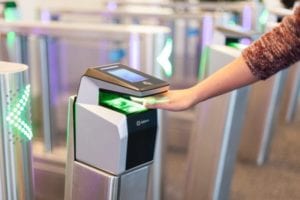“Its matching speed is 85 percent faster, enabling a 25 percent increase in throughput, with the device capable of scanning 50 people per minute.”

IDEMIA‘s renowned MorphoWave Compact biometric solution is now faster and more accurate, thanks to an AI-driven update.
Launched in the spring of 2018, the MorphoWave Compact is a smaller version of the original MorphoWave scanner released in 2015. The device is capable of scanning four fingerprints from a single hand as it’s waved over the scanner, with no need for physical contact, making it an ideal biometric identification solution for high-throughput deployments.
Now, IDEMIA has announced that it has enhanced the MorphoWave Compact’s embedded biometric engine with Artificial Intelligence software that has dramatically improved its functionality. Its matching speed is 85 percent faster, enabling a 25 percent increase in throughput, with the device capable of scanning 50 people per minute. Together with increased accuracy, this makes the MorphoWave Compact an even more appealing option for high-volume applications in settings like stadiums, airports, and the like.
The announcement comes on the heels of IDEMIA’s launch of MFace Flex last week, another solution aimed at high-throughput biometric scanning that revolves around facial recognition instead of fingerprint recognition. It’s all part of the same technological effort on IDEMIA’s part, with the company’s Connected Objects VP, Yves Portalier, commenting in a statement, “This latest innovation is another step towards the future of biometric identification and allows us to remain a leader in Augmented Identity.”
IDEMIA is showcasing the upgraded MorphoWave Compact solution at this week’s Global Security Exchange in Chicago.
–
September 9, 2019 – by Alex Perala
Fingerprints are practically synonymous with identity. The unique ridges and whorls on the tips of your finger have been distinguishing one person from another since 1788 when German anatomist Johann Christoph Andreas Mayer discovered that every fingerprint is different.
Biometric fingerprint readers do exactly what their name describes. Using either optical, capacitive, or ultrasound sensor technology, they measure the characteristics of a fingerprint. This can be used to identify an individual by comparing the scanned print to many different templates stored in a database, as is commonly done with criminal background checks, or it can be done on a one-to-one basis in order to authenticate a user. Visit FindBiometrics’ Fingerprint Biometrics page to learn more.




Follow Us